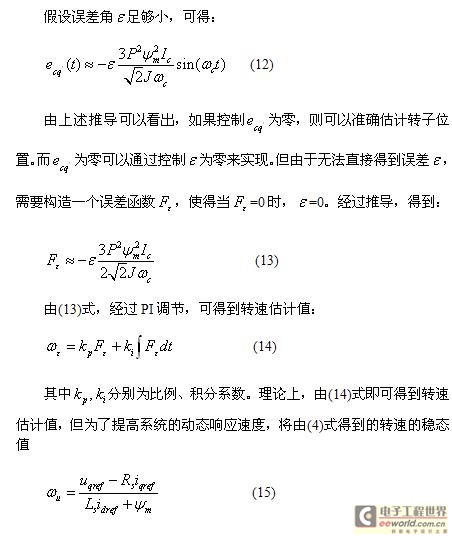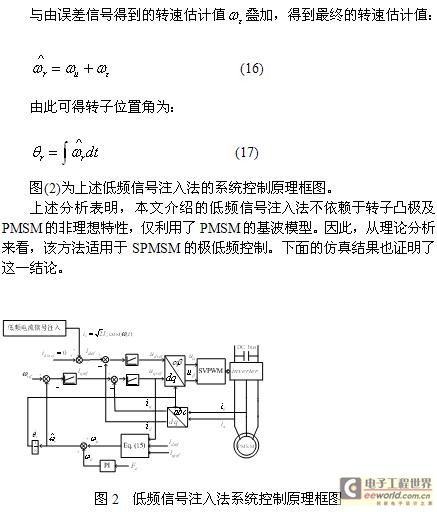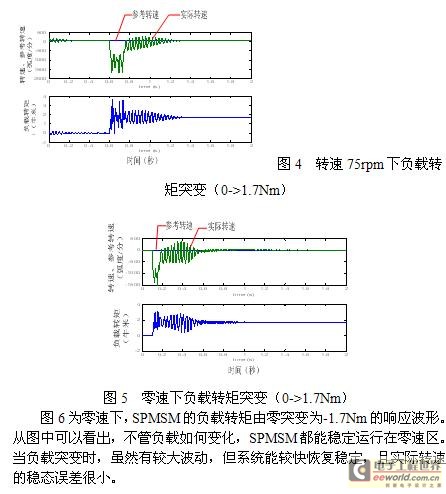1 Introduction
In recent years, speed sensorless vector control of permanent magnet synchronous motor (PMSM) has become a research hotspot. At present, PMSM speed sensorless vector control has achieved good control performance in the medium and high speed range, but has not yet achieved good control in the ultra-low speed range (<1Hz). This is because PMSM speed sensorless vector control requires the use of back electromotive force, which is very small at ultra-low speed and is greatly affected by changes in motor parameters, resulting in reduced control performance and inability to achieve speed sensorless vector control at ultra-low speed and zero speed.
In order to achieve PMSM speed sensorless control at ultra-low speed, researchers have proposed various control methods. Among them, the most studied is the high-frequency signal injection method, which uses the current response generated by the injected high-frequency stator voltage signal to estimate the rotor position [1]-[7]. These methods based on high-frequency signal injection all utilize the non-ideal characteristics of PMSM, such as electromagnetic salient poles and saturation effects. Therefore, these methods are suitable for internal permanent magnet synchronous motors (IPMSM) with rotor salient poles, but have little control effect on surface permanent magnet synchronous motors (SPMSM).
This paper introduces a low-frequency signal injection method [8] and builds a simulation model to realize the speed sensorless control of SPMSM in the extremely low speed section and zero speed area. This method injects a low-frequency d-axis stator current signal and uses the generated back-EMF response to estimate the motor speed. It only uses the fundamental wave model of PMSM and does not rely on various non-ideal characteristics. Therefore, it is suitable for SPMSM control. This paper conducts a large number of simulations and analyzes the simulation results. It not only proves the effectiveness of this method, but also puts forward issues and directions that need further research.
2 PMSM mathematical model








Reference address:Very low speed PMSM sensorless control based on signal injection
In recent years, speed sensorless vector control of permanent magnet synchronous motor (PMSM) has become a research hotspot. At present, PMSM speed sensorless vector control has achieved good control performance in the medium and high speed range, but has not yet achieved good control in the ultra-low speed range (<1Hz). This is because PMSM speed sensorless vector control requires the use of back electromotive force, which is very small at ultra-low speed and is greatly affected by changes in motor parameters, resulting in reduced control performance and inability to achieve speed sensorless vector control at ultra-low speed and zero speed.
In order to achieve PMSM speed sensorless control at ultra-low speed, researchers have proposed various control methods. Among them, the most studied is the high-frequency signal injection method, which uses the current response generated by the injected high-frequency stator voltage signal to estimate the rotor position [1]-[7]. These methods based on high-frequency signal injection all utilize the non-ideal characteristics of PMSM, such as electromagnetic salient poles and saturation effects. Therefore, these methods are suitable for internal permanent magnet synchronous motors (IPMSM) with rotor salient poles, but have little control effect on surface permanent magnet synchronous motors (SPMSM).
This paper introduces a low-frequency signal injection method [8] and builds a simulation model to realize the speed sensorless control of SPMSM in the extremely low speed section and zero speed area. This method injects a low-frequency d-axis stator current signal and uses the generated back-EMF response to estimate the motor speed. It only uses the fundamental wave model of PMSM and does not rely on various non-ideal characteristics. Therefore, it is suitable for SPMSM control. This paper conducts a large number of simulations and analyzes the simulation results. It not only proves the effectiveness of this method, but also puts forward issues and directions that need further research.
2 PMSM mathematical model








From the above simulation results, it can be seen that the low-frequency signal injection method in this paper can realize the speed sensorless vector control of SPMSM in the extremely low speed section or even the zero speed section, and the steady-state error is small and the steady-state performance is good. But there are also some problems. From the simulation results, it can be seen that when the speed or load changes suddenly, the speed pulsation is large, and the dynamic response speed of the system is also slightly slow. Therefore, in order to improve the dynamic response speed of the system and reduce the pulsation, it is necessary to further study the combination of the low-frequency signal injection method in this paper with a more advanced observer to improve the control performance of the extremely low-speed SPMSM.
5 Conclusion
This paper introduces a speed sensorless vector control method of permanent magnet synchronous motor in the extremely low speed section based on low-frequency signal injection method. After theoretical analysis and simulation verification, this method does not rely on the non-ideal characteristics of permanent magnet synchronous motors, and can be obtained only by the fundamental wave model. Therefore, it is not only applicable to embedded permanent magnet synchronous motors, but also to surface permanent magnet synchronous motors without salient poles. Compared with the method based on high-frequency signal injection, it has a wider applicability. However, how to speed up its dynamic response speed and reduce the large speed and torque pulsation in the dynamic process needs to be further studied.
5 Conclusion
This paper introduces a speed sensorless vector control method of permanent magnet synchronous motor in the extremely low speed section based on low-frequency signal injection method. After theoretical analysis and simulation verification, this method does not rely on the non-ideal characteristics of permanent magnet synchronous motors, and can be obtained only by the fundamental wave model. Therefore, it is not only applicable to embedded permanent magnet synchronous motors, but also to surface permanent magnet synchronous motors without salient poles. Compared with the method based on high-frequency signal injection, it has a wider applicability. However, how to speed up its dynamic response speed and reduce the large speed and torque pulsation in the dynamic process needs to be further studied.
Previous article:Design strategy for intelligent video surveillance application system
Next article:A novel speed sensorless control method for extremely low speed asynchronous motor
- Popular Resources
- Popular amplifiers
Latest Industrial Control Articles
- Molex leverages SAP solutions to drive smart supply chain collaboration
- Pickering Launches New Future-Proof PXIe Single-Slot Controller for High-Performance Test and Measurement Applications
- CGD and Qorvo to jointly revolutionize motor control solutions
- Advanced gameplay, Harting takes your PCB board connection to a new level!
- Nidec Intelligent Motion is the first to launch an electric clutch ECU for two-wheeled vehicles
- Bosch and Tsinghua University renew cooperation agreement on artificial intelligence research to jointly promote the development of artificial intelligence in the industrial field
- GigaDevice unveils new MCU products, deeply unlocking industrial application scenarios with diversified products and solutions
- Advantech: Investing in Edge AI Innovation to Drive an Intelligent Future
- CGD and QORVO will revolutionize motor control solutions
MoreSelected Circuit Diagrams
MorePopular Articles
- Innolux's intelligent steer-by-wire solution makes cars smarter and safer
- 8051 MCU - Parity Check
- How to efficiently balance the sensitivity of tactile sensing interfaces
- What should I do if the servo motor shakes? What causes the servo motor to shake quickly?
- 【Brushless Motor】Analysis of three-phase BLDC motor and sharing of two popular development boards
- Midea Industrial Technology's subsidiaries Clou Electronics and Hekang New Energy jointly appeared at the Munich Battery Energy Storage Exhibition and Solar Energy Exhibition
- Guoxin Sichen | Application of ferroelectric memory PB85RS2MC in power battery management, with a capacity of 2M
- Analysis of common faults of frequency converter
- In a head-on competition with Qualcomm, what kind of cockpit products has Intel come up with?
- Dalian Rongke's all-vanadium liquid flow battery energy storage equipment industrialization project has entered the sprint stage before production
MoreDaily News
- Allegro MicroSystems Introduces Advanced Magnetic and Inductive Position Sensing Solutions at Electronica 2024
- Car key in the left hand, liveness detection radar in the right hand, UWB is imperative for cars!
- After a decade of rapid development, domestic CIS has entered the market
- Aegis Dagger Battery + Thor EM-i Super Hybrid, Geely New Energy has thrown out two "king bombs"
- A brief discussion on functional safety - fault, error, and failure
- In the smart car 2.0 cycle, these core industry chains are facing major opportunities!
- The United States and Japan are developing new batteries. CATL faces challenges? How should China's new energy battery industry respond?
- Murata launches high-precision 6-axis inertial sensor for automobiles
- Ford patents pre-charge alarm to help save costs and respond to emergencies
- New real-time microcontroller system from Texas Instruments enables smarter processing in automotive and industrial applications
Guess you like
- The serial port cannot be interrupted, but the register settings are correct when emulating.
- msp430 PWM period calculation
- Latest feeling: There are more beauties after wearing masks
- What are the Bluetooth output power, receiving sensitivity, resolution, TX transmission current, RX receiving current, and data rate?
- 150 examples of amateur production of communication circuits
- USB port size
- This is how to use the LM2596S-ADJ DC-DC step-down chip
- CC1101 433 wireless module, STM8 serial port transparent transmission
- STM32F103 project of LPS33HW
- New Shortlist | 2020-2021 ON Semiconductor and Avnet IoT Creative Design Competition

 AS2111C/XT
AS2111C/XT











 京公网安备 11010802033920号
京公网安备 11010802033920号